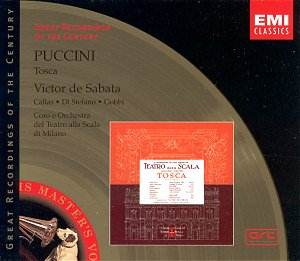This album is a fitting celebration of EMI’s 100th
release in its ‘Great Recordings of the Century’ series.
All honours must go to the meticulously considered
conducting of Victor de Sabata; a true tour de force. De Sabata
was famed for his lack of enthusiasm for the recording process and as
such his legacy is sparse, but, as Richard Osborne comments, "as
a memento of his art and genius, this Tosca is all we need. I
cannot resist quoting from Conrad L. Osborne’s assessment of this recording
in The Metropolitan Opera Guide: "De Sabata shows the essential
operatic understanding – that of how each accent, each rhythmic event,
each melodic scrap or harmonic tint, can be used without distortion
or undue highlighting to help impel the dramatic moment, to build the
dramatic arch and maintain suspense. The power of his Te Deum
is unequalled in my experience, and in the confrontations of Act 2,
the conductor unleashes orchestral storms that are all the more vicious
for being so disciplined and focused". Indeed, and Walter Legge
clearly indulged de Sabata allowing two sessions, six hours, to record
the Te Deum with Gobbi and de Sabata going over some passages
as many as thirty times. Tosca’s entry with its five-fold cry of ‘Mario’
was endlessly experimented with to obtain the required distance and
atmosphere. This mono recording is so finely calculated, so considered
in the creation of its wide perspectives that one hardly misses any
stereo refinement. Just listen to the dynamics and perspectives of the
bells awakening Rome at the beginning of Act II, for instance. De Sabata
clearly has thought through every bar starting from the very beginning
where the orchestra’s underlining of the escaping prisoner, Angelotti’s
anxiety and urgency is more palpable than in any other Tosca
I can recall.
I do not need to add to the miles of text extolling
the virtues of Callas’s Tosca in this recording. She probed deep into
the psychology of the role to discover all Tosca’s jealousies and histrionics
yet also her conscientiousness, graciousness and piety. Her duets with
di Stefano are spellbinding but the highlight is of course her moving
rendering of "Vissi d’arte".
Tito Gobbi brings an oily, merciless malevolence to
the role of Scarpia. Richard Osborne observes that Gobbi was advised
that "Scarpia was a vulture … looking down on people ready to pounce
and therefore regarding them from a height …" He is the perfect
foil to Callas’s jealous entreaties and vengeful anger, and to di Stefano’s
vainful heroics.
Sadly, no mention is made of Giuseppe di Stefano’s
contribution in Richard Osborne’s otherwise excellent notes (perhaps,
mention was edited out through lack of space?). Di Stefano might be
criticised for sometimes taking liberties, short-cornering some of the
text, but that lovely legato tone and undeniable virility must certainly
be admired. Actually I think he fared even better in the 1971 Karajan
recording with Leontyne Price as Tosca and Giuseppe Taddei as Scarpia
(Decca 421 670-2DM2).
While thinking of Osborne’s notes, he makes the interesting
point that Alec Robertson and several other critics writing in 1953
were not very impressed with this recording preferring, to Callas, "Tebaldi’s
beauty of tone and perfection of control."
Mention should also be made of the expressive quality
of Melchiorre Luise’s sanctimonious Sacristan – a portrayal almost as
odious as Scarpia.
In short this is the Tosca to
die for – a true classic of the gramophone and a set that just has to
be in every opera-lovers’ collection and a fitting celebration of 100
EMI Great Recordings of the Century.
Ian Lace


